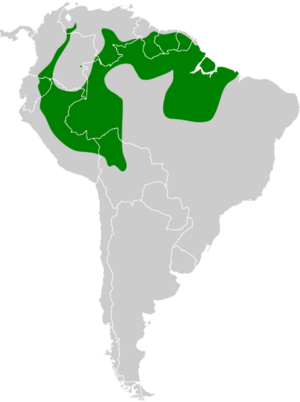Chestnut-crowned foliage-gleaner facts for kids
Quick facts for kids Chestnut-crowned foliage-gleaner |
|
|---|---|
 |
|
| At Serra dos Carajás, Pará, Brazil. | |
| Conservation status | |
| Scientific classification | |
| Genus: |
Automolus
|
| Species: |
rufipileatus
|
 |
|
| Synonyms | |
|
|
The chestnut-crowned foliage-gleaner (Automolus rufipileatus) is a cool bird from the ovenbird family. It lives in many South American countries. You can find it in places like Bolivia, Brazil, Colombia, Ecuador, French Guiana, Guyana, Peru, Suriname, and Venezuela. This bird is known for its reddish-brown crown, which looks a bit like a chestnut!
Contents
Meet the Family: Bird Relatives
The chestnut-crowned foliage-gleaner has a close relative. It's called the brown-rumped foliage-gleaner. These two birds are like "sister species." This means they are very closely related.
There are two main types, or subspecies, of the chestnut-crowned foliage-gleaner. One is called A. r. rufipileatus. The other is A. r. consobrinus.
What Does It Look Like?
This bird is about 18 to 19 centimeters (7 to 7.5 inches) long. It weighs about 31 to 38 grams (1.1 to 1.3 ounces). Both male and female birds look the same.
Adult chestnut-crowned foliage-gleaners have a reddish-brown face. They have some lighter streaks near their ears. Their head is a dark reddish-chestnut color. This color fades to a dark olive-brown on their back. Their lower back is reddish-brown. Their tail feathers are a reddish-chestnut.
Their wings are a dark reddish-brown. The bend of their wing is a yellowish-red. Their tail is a dark, dull chestnut color.
Their throat is a bright yellowish-brown. This color becomes a pale yellowish-brown on their chest and belly. Their sides are a dull brown. Their under-tail feathers are a dull reddish-brown.
Their eyes are yellow-orange or orange. Their upper beak is blackish to olive-gray. Their lower beak is silvery or grayish-olive. Their legs and feet are greenish-gray or yellowish-olive.
Young birds look a bit duller and darker than adults. They have dark edges on their chest and belly feathers. The A. r. consobrinus subspecies has a more reddish back. Its underparts are darker and more yellowish-red than the other type.
Where Does It Live?
The chestnut-crowned foliage-gleaner lives in almost all mainland South American countries. It is not found in Argentina, Chile, Paraguay, or Uruguay.
The A. r. consobrinus subspecies lives in a much larger area. It is found in the northern and western Amazon Basin. This includes eastern Colombia, southern Venezuela, and the Guianas. It also lives south through eastern Ecuador, eastern Peru, and western Brazil. It even reaches into northwestern Bolivia.
The other subspecies, A. r. rufipileatus, lives in Brazil. It is found south of the Amazon River.
These birds mostly live in forests near rivers. They especially like thick areas of bamboo and cane plants. They can also be found in bamboo patches inside other types of forests. They usually live from sea level up to about 500 meters (1,600 feet) high. Sometimes, they can be found as high as 1,300 meters (4,300 feet).
How Does It Behave?
Staying Put
The chestnut-crowned foliage-gleaner does not migrate. It stays in the same area all year long.
What's for Dinner?
This bird mainly eats different kinds of insects and spiders. Sometimes, it even eats small tree frogs! It usually hunts for food in pairs. It rarely joins large groups of different bird species. It looks for food from the forest floor up to the middle parts of the trees. It is very agile. It pulls prey from leaves and other plant bits.
Family Life
We don't know much about how the chestnut-crowned foliage-gleaner raises its young. We only know that males in Venezuela were ready to breed in February. This is a small hint about their breeding season.
What Does It Sound Like?
The song of the chestnut-crowned foliage-gleaner is a fast series of sharp, short notes. It sounds like "d-r-r-r-r-r-r-r-r-r" and drops in pitch. Another way to describe it is a short, shaky, quick trill like "kriiiiiiih." This song lasts about 1.5 seconds. Its call is a unique, deep sound, like "jyoo" or "cheeu."
How Is Its Population Doing?
The IUCN (International Union for Conservation of Nature) says the chestnut-crowned foliage-gleaner is of "Least Concern." This means it is not currently in danger of disappearing. It lives across a very large area. However, we don't know exactly how many of these birds there are. Experts believe their numbers might be going down. No major threats have been found for them right now.
Even though it's found in many places, it's considered uncommon to fairly common. Its habitat, which is mostly along rivers, naturally limits how many birds there can be worldwide. Luckily, it lives in several protected areas.


